The Homeland Security Market is estimated to be valued at USD 216.9 million in 2025 and is projected to reach USD 343.3 million by 2035, registering a compound annual growth rate (CAGR) of 4.7% over the forecast period.
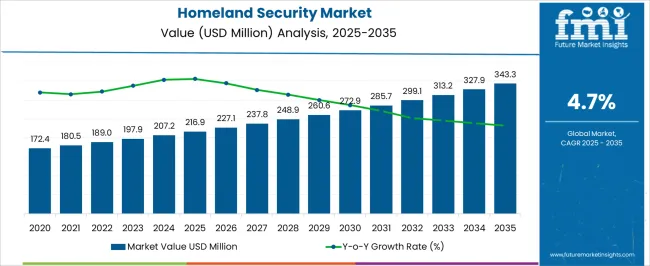
| Metric | Value |
|---|---|
| Homeland Security Market Estimated Value in (2025 E) | USD 216.9 million |
| Homeland Security Market Forecast Value in (2035 F) | USD 343.3 million |
| Forecast CAGR (2025 to 2035) | 4.7% |
The homeland security market is experiencing strong and sustained expansion driven by escalating geopolitical tensions, rising cross border threats, and increased frequency of natural and manmade disasters. Governments across the globe are prioritizing national security infrastructure upgrades and implementing advanced surveillance, threat detection, and emergency response systems.
Digital transformation within public safety and defense has led to increased deployment of AI powered analytics, biometric systems, and cyber intelligence tools. Emerging threats such as cyberattacks and drone intrusions are accelerating the adoption of integrated security frameworks across land, air, and maritime domains.
The global focus on population safety, border control, and critical infrastructure protection is fueling long term investment across both public and private sectors. As a result, the market outlook remains positive with expanding opportunities in data driven threat management, interoperable communication systems, and rapid response technologies.
The market is segmented by End-User and Security Type and region. By End-User, the market is divided into Public Sector and Private Sector. In terms of Security Type, the market is classified into Border security, Mass transit security, Cyber security, Critical infrastructure security, Aviation security, Maritime security, and Others. Regionally, the market is classified into North America, Latin America, Western Europe, Eastern Europe, Balkan & Baltic Countries, Russia & Belarus, Central Asia, East Asia, South Asia & Pacific, and the Middle East & Africa.
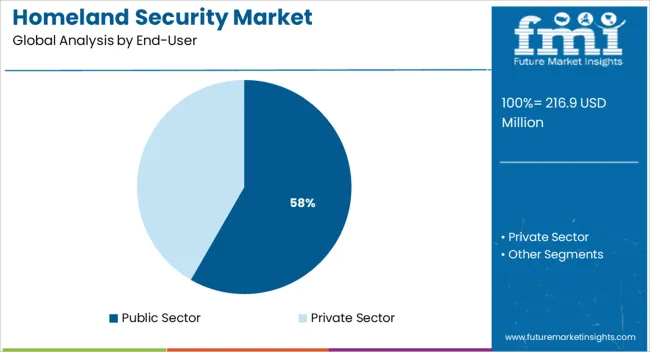
The public sector segment is projected to contribute 58.30% of the total market revenue by 2025 within the end user category, positioning it as the dominant contributor. This leadership is attributed to the strategic role of government agencies in national defense, law enforcement, and emergency management operations.
Increased government spending on modernizing homeland security infrastructure, including surveillance systems, command control centers, and border management technologies, has accelerated public sector engagement. Initiatives aimed at enhancing national resilience against both physical and cyber threats have led to the adoption of advanced integrated systems.
Public sector entities also play a central role in coordinating disaster response, public health safety, and counterterrorism efforts. With growing global security concerns and the rising need for real time situational awareness, the public sector continues to lead market demand and technology adoption in homeland security operations.
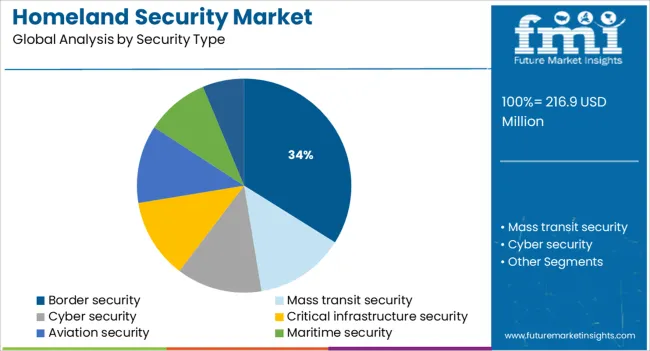
The border security segment is expected to account for 33.90% of total market revenue by 2025 within the security type category, making it the leading area of focus. This dominance is driven by increasing challenges related to illegal immigration, trafficking, smuggling, and geopolitical border disputes.
Governments are investing heavily in the deployment of physical and digital surveillance tools including motion sensors, biometric checkpoints, unmanned aerial systems, and AI enabled monitoring platforms to secure international borders. The critical nature of border protection for safeguarding national sovereignty and economic stability has prioritized this segment in security planning.
In addition, rising global migration flows and transnational criminal activity are intensifying the need for multilayered border surveillance and enforcement systems. The combination of evolving threat landscapes and national security mandates has firmly established border security as a primary area of investment and innovation within the homeland security market.
The global demand for Homeland Security is projected to increase at a CAGR of 4.7% during the forecast period between 2025 and 2035, reaching a total of USD 343.3 Billion in 2035, according to a report from Future Market Insights (FMI). From 2020 to 2024, sales witnessed significant growth, registering a CAGR of 3%.
The word homeland security refers to a country's defense against any threat to society. Governments have attempted to provide security and resilience in the face of all probable natural and man-made disasters. Terrorism, illegal weapons, cybercrime, drug trafficking, hurricanes, floods, earthquakes, tornadoes, and other natural disasters are all part of a country's homeland security. It safeguards the public by incorporating law enforcement, border security, transit security, and aviation security.
The market for homeland security is expected to grow rapidly as a result of reasons such as a rise in terrorist attacks, border disputes, illegal immigration, smuggling, human trafficking, and regular natural disasters, among others. Several companies are spending heavily on innovative goods and services to address and defend negative circumstances in nations throughout the world.
Initiatives to de-escalate Cross-Border Conflicts and Civil Wars to Accelerate Market Growth
Civil conflicts and border disputes are growing increasingly common across the world. Border conflicts between states develop for a variety of reasons, including terrorism, expansionism, control over natural resources, and so on. Civil wars are common in a country and are mostly triggered by conflicts arising from political dissatisfaction, territorial disputes between governments, and other circumstances.
Governments throughout the world are taking considerable steps to control these circumstances, and as a result, they are investing more in their country's homeland security to manage the growing number of conflicts. In 2024, the United States, for example, will spend USD 49.8 billion on homeland security. This demonstrates the country's responsibility to defend its citizens both within its borders and online.
Increased Smuggling and Trafficking to Propel Market Growth
Global, transnational criminal activity is fuelled by smuggling and trafficking. Smuggling and trafficking, which includes drug trafficking, human trafficking, and illegal immigration, is the world's fastest-growing anti-social threat. Numerous global factors, including the Asian economic crisis, ongoing conflicts in Iraq, Afghanistan, and Pakistan, and prolonged poverty in many countries, including Paraguay, Namibia, Botswana, Mozambique, and Uruguay, have all contributed to the alarming increase in immigration from these countries.
Because of the dramatic increase in occurrences of human trafficking, the market for global homeland security is expected to grow, as the goods and services on sale in the marketplace aid in detecting and fighting this danger. Airport security patrols, naval security, transit security, and the identification of smuggled nuclear material are just a few of the efforts used to handle smuggling and trafficking issues that undermine a country's national security.
The High Costs of Ensuring Homeland Security to Hinder Market Growth
Costly technology, commodities, and services provided by various homeland security agencies are expected to limit the market growth. Because of the high cost of products and services, as well as government expenditure, countries such as Asia-Pacific and the Middle East have slower adoption rates for homeland security services.
Furthermore, the installation expenses for these technologies are rather substantial. A large amount of money, people, and equipment must be set aside for homeland security resources, which adds to the cost of keeping the country safe. For example, the United States spends around USD 100 billion per year on homeland security. This involves the enforcement of federal, state, and municipal laws, as well as the provision of emergency services.
Due to the high cost of goods and services such as expensive x-ray and explosive detection equipment, high-end cybersecurity devices, high-end real-time video analytics systems, and others, the public and private sectors have lower implementation and investment in the market of high-cost security surveillance systems. This factor will restrain worldwide market growth over the forecast period.
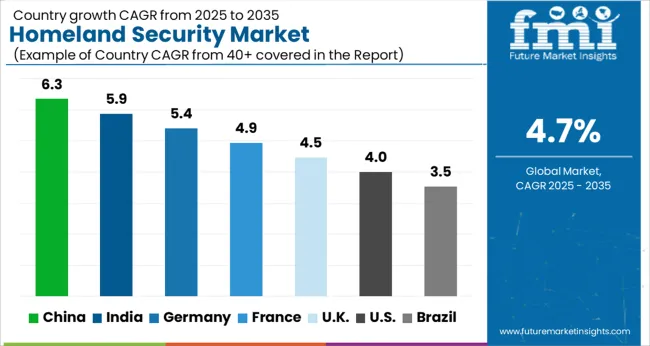
Adoption of New Technologies in Different Security Areas to Widen Profit Margins
The Asia-Pacific region is the second-largest. Nations with large marine borders, such as India, Sri Lanka, Japan, and Bangladesh, seek improved naval security in the area. Government attempts to improve public and property safety, as well as the adoption of new technologies in different security areas such as cyber security, aviation security, and critical infrastructure security, are creating huge prospects for market expansion in the region.
As per Future Market Insights, the Asia Pacific is expected to grow at a CAGR of 4% market share for homeland security in the assessment period 2025 to 2035.
Various Military Modernization and Upgrade Initiatives to Drive Market Growth
Because of the various military modernization and upgrade initiatives happening in the area, North America is anticipated to see an increase in the use of homeland security goods and services. The increased investment by North American governments in upgrading national security against various threats is projected to promote the development of modern equipment across North America.
The presence of world-class defense equipment manufacturers in the area improves the region's contribution to the worldwide market. As per Future Market Insights, North America is expected to grow at a CAGR of 4.5% market share for homeland security in the assessment period 2025 to 2035.
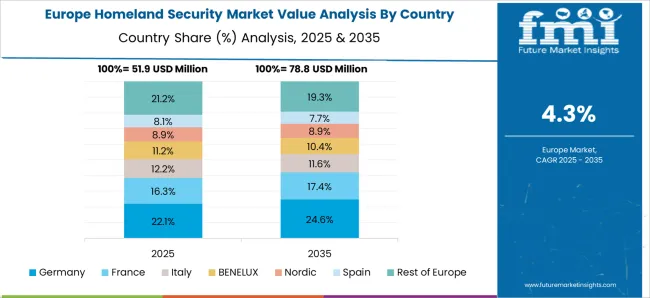
Increased Government Spending fuelling sales of Homeland Security
The European homeland security market covers nations such as the United Kingdom, Germany, France, and the rest of Europe. The key factor fuelling the growth of the homeland security industry is increased government spending in the region.
The existence of large nations such as Germany, France, the United Kingdom, Russia, and others that effectively protect their internal security is likely to boost the growth of the homeland security industry. As per Future Market Insights, Europe is expected to grow at a CAGR of 3.7% market share for homeland security in the assessment period 2025 to 2035.
Public Homeland Security to be of Vital Importance in Coming Years
The market's largest contributor is public security, which is expected to increase at a CAGR of 4.3% during the projected period. Several governments and defense agencies throughout the world have adopted homeland security goods and services. Government organizations such as the International Civil Aviation Organization (ICAO), a United Nations agency, Customs and Border Protection (CBP) in the United States, the Border Security Force (BSF) in India, the Maritime Civil and Criminal Authority, the Australian Maritime Safety Authority, and many others are heavily utilizing market products and services.
Homeland Cybersecurity to take Precedence, amid growing Threat of Data Breaches
Cyber Security has the largest share of the homeland security market and is expected to grow at a CAGR of 4.6% over the projected period. Cybersecurity is critical to ensuring the protection of data that, if compromised, may disrupt the operations of enterprises all over the world.
A strong cybersecurity infrastructure safeguards all types of data against theft. The increasing severity and frequency of cyber-attacks are expected to drive growth in this category during the projected period.
Key start-up players in homeland security are from offering new and innovative product lines to consolidating their market presence, these aforementioned start-ups have left no stone unturned. Some specific instances of key homeland security start-ups are as follows:
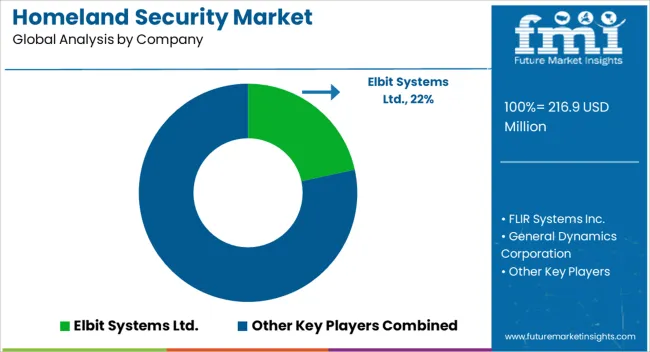
Key players in the Homeland Security market are Raytheon Technologies, IBM, L-3 Harris Technologies, Lockheed Martin Corporation, and Northrop Grumman.
Recent Developments
| Report Attribute | Details |
|---|---|
| Market Value in 2025 | USD 216.9 million |
| Market Value in 2035 | USD 343.3 million |
| Growth Rate | CAGR of 4.7% from 2025 to 2035 |
| Base Year for Estimation | 2024 |
| Historical Data | 2020 to 2024 |
| Forecast Period | 2025 to 2035 |
| Quantitative Units | Revenue in USD Billion and CAGR from 2025 to 2035 |
| Report Coverage | Revenue Forecast, Company Ranking, Competitive Landscape, Growth Factors, Trends, and Pricing Analysis |
| Segments Covered | End User, Security Type, Region |
| Regions Covered | North America; Latin America; Europe; South Asia; East Asia; Oceania; Middle East & Africa |
| Key Countries Profiled | The USA, Canada, Brazil, Mexico, Germany, The United Kingdom, France, Spain, Italy, China, Japan, South Korea, India, Malaysia, Singapore, Australia, New Zealand, GCC Countries, South Africa, Israel |
| Key Companies Profiled | Elbit Systems Ltd.; FLIR Systems Inc.; General Dynamics Corporation; Harris Corporation; L-3 Communications Holding Inc.; Megal Security Systems Ltd.; Raytheon Company; Safran SA; Thales SA; Unisys Corporation |
| Customization | Available Upon Request |
The global homeland security market is estimated to be valued at USD 216.9 million in 2025.
The market size for the homeland security market is projected to reach USD 343.3 million by 2035.
The homeland security market is expected to grow at a 4.7% CAGR between 2025 and 2035.
The key product types in homeland security market are public sector and private sector.
In terms of security type, border security segment to command 33.9% share in the homeland security market in 2025.






Full Research Suite comprises of:
Market outlook & trends analysis
Interviews & case studies
Strategic recommendations
Vendor profiles & capabilities analysis
5-year forecasts
8 regions and 60+ country-level data splits
Market segment data splits
12 months of continuous data updates
DELIVERED AS:
PDF EXCEL ONLINE
Security Tape Market Size and Share Forecast Outlook 2025 to 2035
Security Alarm Communicator Market Size and Share Forecast Outlook 2025 to 2035
Security and Vulnerability Management Market Forecast and Outlook 2025 to 2035
Security Holograms Market Size and Share Forecast Outlook 2025 to 2035
Security Paper Market Size and Share Forecast Outlook 2025 to 2035
Security System Tester Market Size and Share Forecast Outlook 2025 to 2035
Security Advisory Services Market Size and Share Forecast Outlook 2025 to 2035
Security Room Control Market Size and Share Forecast Outlook 2025 to 2035
Security Cameras (IR Illuminator) Market Size and Share Forecast Outlook 2025 to 2035
Security Operation Centre as a Service Market Size and Share Forecast Outlook 2025 to 2035
Security Robots Market Size and Share Forecast Outlook 2025 to 2035
Security Service Edge Market Size and Share Forecast Outlook 2025 to 2035
Security and Surveillance Equipment Market Size and Share Forecast Outlook 2025 to 2035
Security Orchestration Automation and Response (SOAR) Market Size and Share Forecast Outlook 2025 to 2035
Security Bags Market Size and Share Forecast Outlook 2025 to 2035
Security Screening Market Analysis - Size, Share, and Forecast 2025 to 2035
Security Bottles Market Size and Share Forecast Outlook 2025 to 2035
Security Inspection Market Insights – Trends & Forecast 2025 to 2035
Security Labels Market Analysis by Product Type, Material, Pattern, Application, End-Use Industry, and Region Through 2035
Market Share Breakdown of Security Bags Manufacturers

Thank you!
You will receive an email from our Business Development Manager. Please be sure to check your SPAM/JUNK folder too.
Chat With
MaRIA